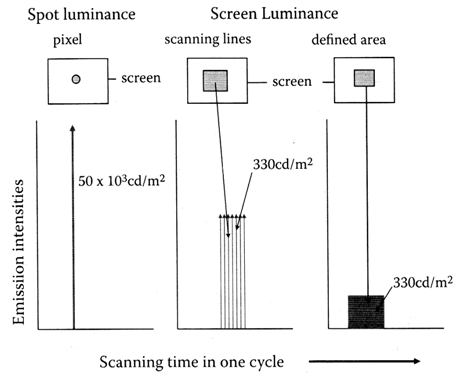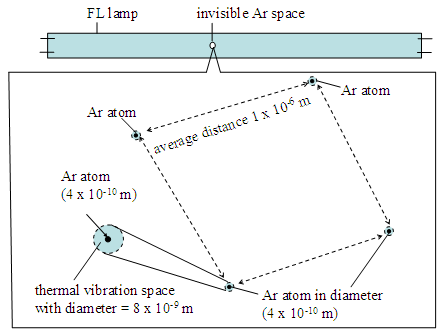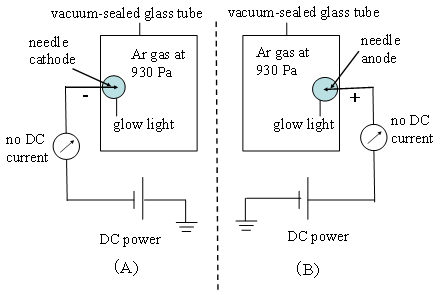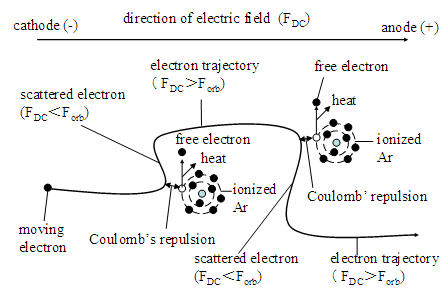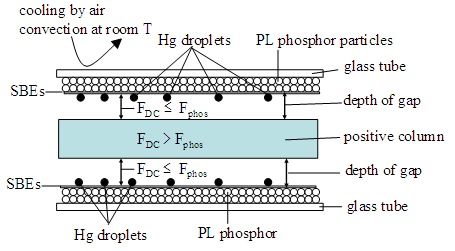-
Paper Information
- Paper Submission
-
Journal Information
- About This Journal
- Editorial Board
- Current Issue
- Archive
- Author Guidelines
- Contact Us
International Journal of Energy Engineering
p-ISSN: 2163-1891 e-ISSN: 2163-1905
2017; 7(4): 91-113
doi:10.5923/j.ijee.20170704.01

Coil-EEFL Lamps as a Promise Candidate for Green Energy Project of UN
Lyuji Ozawa
Professor and Licensed Consultant on Applied Science, Beijing, China
Correspondence to: Lyuji Ozawa, Professor and Licensed Consultant on Applied Science, Beijing, China.
| Email: |  |
Copyright © 2017 Scientific & Academic Publishing. All Rights Reserved.
This work is licensed under the Creative Commons Attribution International License (CC BY).
http://creativecommons.org/licenses/by/4.0/

We have studied the incandescent lamps for aiming to the contribution of the Paris Agreement of the United Nation. We have found that only FL lamps hold the great potential as the candidate to the UN project. However, the careful study on the commercial HCFL lamps has produced with the hypotheses without the scientific proofs. After the clarification of the hypotheses, we have developed the coil-EEFL lamps that brilliantly emit the visible lights with the Wact = 0. The coil-EEFL lamps form the internal DC electric driving circuit in the Ar gas space, without the flow of the electrons from the external driving circuit. The coil-EEFL lamps in the parallel connection in the vacuum-sealed container can be operated with WDC = 0 that allows the immediate reduction of the electric power consumption on the world more than 30%. The results will contribute to the Green Energy Project by United Nation in a near future.
Keywords: Green Energy, Paris Agreement, FL lamp, Quantum Efficiency, Power Consumption
Cite this paper: Lyuji Ozawa, Coil-EEFL Lamps as a Promise Candidate for Green Energy Project of UN, International Journal of Energy Engineering, Vol. 7 No. 4, 2017, pp. 91-113. doi: 10.5923/j.ijee.20170704.01.
Article Outline
1. Introduction
- The Paris Agreement of the United Nation on 2016 gives us an urgent target that is the reduction of the pollution level in air more than 40% from the present level. However, no one gives us a suggestion how to reduce the large amount of the polluted gases in the air on the Earth as soon as possible, without a sacrifice of our ordinary activity. We suppose automobiles and light sources on the world inevitably release the large amount of the polluted gases and tiny particles (e.g., PM 2.5) in air on the Earth. The largest sources of the pollution in air at present time attribute to (i) driving of automobiles and (ii) light sources in the dark. The automobiles are shitting to the electric cars. However, the driving of the electric cars consumes electricity generated at electric power generators on the world. The shifting of the automobiles to the electric cars does not reduce the total pollution levels in the air on the world. Here we have considered a real reduction of the pollution level from the electric power generators on the world by the reduction of the electric power consumption of the incandescent lamps. According to the report of COP (Conference of Particles, 2015) of the Unite Nation, the electric power consumption of the lamps on the world is around 31% of totally generated electric powers on the world. The commercial incandescent amps are operated with the AC electric powers. If we can reduce the active power consumption (Wact) of the incandescent lamps to zero, Wact = 0, the results will be a real reduction of the air pollution from the electric power generators on the world. According to the conclusion, we have challenged this target. For the realization of the target, we have studied the incandescent lamps from the basics of the lighting mechanisms [1, 2]. The incandescent lamps generate the visible lights by the moving electrons in the vacuum space between atoms at the lattice sites. The typical incandescent lamps in our life activity are (a) tungsten (W) filament lamps, (b) light emitting diode (LED) lamps and (c) fluorescent (FL) lamps. All of them are operated with the electric driving circuit. We will analyze the fundamentals of the lighting mechanisms of the established incandescent lamps.
2. A Brief Summary of Developed Incandescent Lamps
- For the developments of the most advanced incandescent lamp, at first, we must know about the target of the illumination level of the developed incandescent lamps. The required illumination levels in the dark are determined by the characters of the naked eyes of the human. Human have the daytime activity under the slightly overcastting sky for more than 5 million years. Therefore, the eyes of the human have adjusted to the daytime scenery under the slightly overcastting sky, that gives the images of less shadow with the scattered lights. The comfortable images are given by either illuminance (~ 300 lm, m-2), or luminance (300 cd, m-2), corresponding to the numbers of 1025 visible photons per second per m2. It should note that the incandescent lamps never evaluate with the luminous efficiency (lm, W-1). The luminous efficiency is for the study on the colorimetry. The W of the luminous efficiency is the energy of the visible photons and is not the consumed-electric energy of the driving circuit of the incandescent lamps. The consumed electric energy should be given by either Wact for the AC driving circuit, or WDC for the DC driving circuit, for avoidance of the confusion. We take the Wact and/or WDC as the electric power consumption of the incandescent lamps.
 | Figure 1. Evolution of candescent and incandescent lamps. SLS is solid lighting sources |
2.1. Tungsten (W) Filament Lamps
- Nerveless metals are observed by the naked eyes, metals are composed with densely arranged metal atoms in diameter at around 3 x 10-10 m that are invisible by the naked eyes. By the invisible atomic level, the metal atoms at the lattice sites are bounding with the electrons in the upper electric shell of the metal atoms. The bonding shell of the metallic atoms is either one of (s, or p, and d shells) by the given metal atoms. For example, the most popular metal filament lamps are the tungsten (W) filament lamps. The bonding shell of the W-atoms is the 5d10 electron shell that has the capability of 10 electrons. The most upper shell of the W-atom is not completely filled by the electrons. The 5d10 shell of W-atom has only 4 electrons, 5d4. Consequently, the bounding shell of each W-atom at the lattice sites has 6 vacancies in the bonding shell. Each W-atom in metal has the capacity of the acceptance of 6 moving electrons in the bonding shell. Consequently, the electrons in the metals move on in the inside of the bonding 5d4 shell of the W-atoms, as illustrated in Figure 2 (A). No vacuum space between W-atoms at the lattice sites involve in the moving electrons in the W-filament metal.
 | Figure 2. Schematic illustrations of 4 bounding electrons and 6 empty electrons in 5d10 electron shell of W atoms (A) and lighting W-filament lamp by Joule Heat under DC power source (B) |
2.2. LED Lamps
- LED lamps use semiconductor crystals that atoms are tightly bounded with electrons in upper electric shell of atoms. The bounding of the semiconductors is called as the covalent bonding of the atoms. The semiconductor crystals have well studied with the Si crystals as the semiconductor elements. The covalent bonding in Si4+ crystal does not have the vacancy of the electron in the bonding shell. Consequently, the pure Si crystal does not have the moving electrons in neither the bonding shell nor the vacuum space between Si4+ at lattice sites. The pure Si crystal is the electric insulator. As the Si crystal contains a small amount P5+, each P5+ has one extra electron in the bonding shell. One extra electron in P5+ stays in the narrow vacuum space between Si atoms at lattices. The extra electrons in the Si(P) only move on in the narrow vacuum space between lattice sites, giving rise to the n-type semiconductor. As the Si crystal contains a small amount B3+, the covalent bonding lucks one bonding electron (i.e., hole), giving rise to the p-type semiconductor. The p-type semiconductor actually picks up one electron from the narrow vacuum space between Si at the lattice sites. Figure 3 illustrates the covalent bonding of Si crystal and formation of n-type and p-type semiconductors.
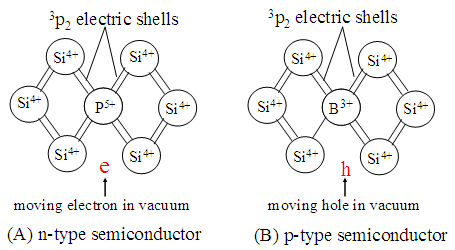 | Figure 3. Schematic illustrations of n-type and p-type Si semiconductors |
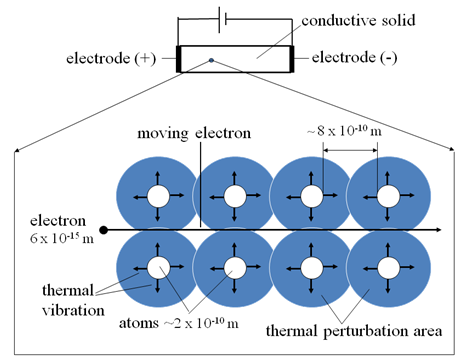 | Figure 4. Schematic illustrations of moving electron in vacuum between atoms at lattice sites and thermally vibrating atoms at lattice sites |
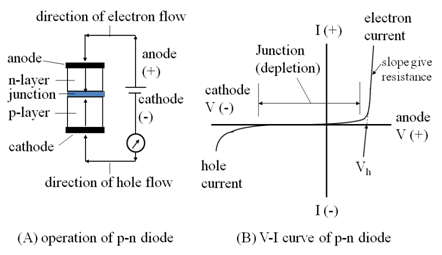 | Figure 5. Illustrates formation of LED lamp that joins n-layer and p-layer are joined with junction layer (A), and characteristic property of junction in V-I curve in operation (B) |
2.3. Fluorescence (FL) Lamps
- Other incandescent lamp is FL lamp that uses moving electrons in wide vacuum space between Ar atoms. The Ar gas pressure in the established FL lamps is around 930 Pa (7 Toll). The largest difference is the size of the FL lamps. The commercial 40W-HCFL lamps have the diameter of 3.2 x 10-2 m (T-10) with 1.2 m long. The next large difference is the vacuum space between Ar atoms (10-6 m) in the FL lamps, as compared with 10-8 m of LED and W-filament lamps. Accordingly, the conditions of the moving electrons in FL lamps quite differ from the conditions of the LED and W-filament lamps. Figure 7 shows photograph of lighted FL lamps (A) and structure of FL lamps (B). The commercial FL lamps are composed with six parts. They are (i) vacuum-sealed glass tube, (ii) BaO particles on the W-filament coil as the electrodes at the both ends of FL lamps, (iii) Ar gas pressure at 930 Pa (= 7 Torr), (iv) vapor pressure of Hg atoms at around 0.1 Pa (= 1 x 10-3 Torr), (v) opaque phosphor screen on inner glass wall that transduces the UV lights to visible lights and (vi) FL lamps are operated with the AC driving circuits.The FL lamp had invented by F. Mayer on 1928 [7]. Since then, the many scientists and engineers have studied on the FL lamps for nearly 90 years. After many trials, they have developed the hotcathode FL (HCFL) lamps as the favorable incandescent lamps. The developed HCFL lamps brilliantly light up by the moving electrons in the vacuum space between floating Ar atoms in vacuum. They paid their attention to the optimization of the developed HCFL lamps for the practical use. Their studies have summarized in many publications and Handbooks. The typical publications and Handbooks are references [8-11]. With the large annual production volume and many technical works, it has believed that technologies involved in the commercial HCFL lamps have well established as the mature technologies.
 | Figure 7. Photopicture of outlook of HCFL lamp (A) and structures of HCFL lamps composed with six parts (B) |
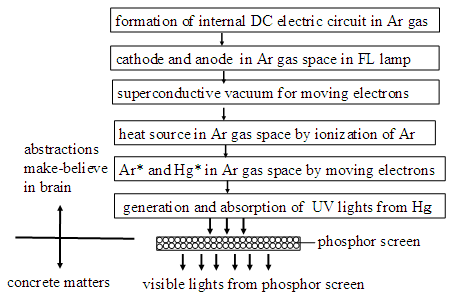 | Figure 8. Illustration of abstraction and concrete matters involved in operation of FL lamps |
2.3.1. Fundamentals of Ar Gas Space between Ar Atoms in Commercial FL Lamps
- The great advantage of the FL lamps comes from the use of Ar gas of the pressure at 930 Pa (7 Torr). The melting point of Ar atoms is -189°C, and boiling point is -186°C. At the temperatures above the boiling point, Ar atoms in diameter of 4 x 10-10 m (= 4 Å) only exist as gas phase. The temperatures of the Ar gas in the lighting FL lamps are higher than the room temperatures. The inner volume of the commercial 40W-HCFL lamps (T-10) in 1.0 m long is 7 x 10-4 m3 {= πr2 x l = (1.5 x 10-2 m)2 x π x 1.0 m). Huge numbers of the Ar atoms in the diameter in 4 x 10-10 m float in the vacuum in the FL lamps. We may calculate the numbers of Ar atoms in the FL lamp at pressure of 930 Pa (7 Torr). The numbers of the Ar atoms in a given FL lamp is calculated from the Boyle-Charles law (PV = mRT) and Avogadro’s numbers. Where P is pressure at atmosphere, V is inner volume of the FL lamp, m is mole, R is gas constant (8.32 J/K. mol), and T is temperature by oK. The rounded Ar gas pressure (P) in the FL lamp is ≈ 0.01 atmospheres {= 7 Torr x (760 Torr)-1}. RT = 2.5 x 103 Joule (= 8.32 J/K x 300 oK). P/(RT) = 4 x 10-6 {= (1 x 10-2) x (2.5 x 103)-1}. Mole of the Ar gas in the FL tube is given by {m = V x P(RT)-1} that is 2.8 x 10-9 mole (=4 x 10-6 x 7 x 10-4 m3). The numbers of the Ar gas atoms in the FL lamp are calculated by the Avogadro’s number (6 x 1023 per mole). The numbers of Ar atoms in the FL lamp are calculated as 1.7 x 1015 Ar atoms (= 6 x 1023 x 2.8 x 10-9 mole). The separation distance of the Ar atoms in the FL lamps is calculated by the unit volume (m3). The numbers of the Ar atoms in m3 are 2 x 1018 atoms per m3 {= 1.7 x 1015 x (7 x 10-4 m3)-1}. The Ar atoms arranged on one side of 1 m3 are 1.2 x 106 Ar atoms m-1 (= (2 x 1018 m-3)1/3. The rounded average separation distance between Ar atoms on the side of the cubic is 1 x 10-6 m {= 1 m x (1.2 x 106)-1} ≈ 1 μm. The vacuum space between 1 μm is much wider vacuum space of the moving electrons in the diameters 5.6 x 10-15 m. Figure 9 illustrates the calculated results. The calculated vacuum space (10-6 m) between Ar atoms inform us that the electrons in the lighted FL lamps may move on in the very wide vacuum space, as compared with the moving electrons in the solids (10-9 m vacuum space). Therefore, we cannot take the concepts of the moving electrons that have been determined by the solids and metals. The diameter of the Ar atoms is 3.8 x 10-10 m (= 3.8 Å) that is very small size as compared with the separation distance between Ar atoms, 1 x 10-6 m. The individual Ar atoms float in vacuum with the very large separation distance from neighboring Ar atoms, as illustrated in Figure 9. The large separation distance indicates that the Ar atoms in FL lamp never bind up with the orbital electrons of the neighboring Ar atoms. Each Ar atom in the FL lamps isolates each other in the vacuum. Isolated Ar atoms in the vacuum thermally vibrate at the floating position. The volume of the thermal vibration of each Ar atom at the room temperature is confined in the diameter of 8 x 10-9 m (8 nm). Consequently, the moving electrons in the wide vacuum space between Ar atoms in FL lamps do not have the thermal perturbation (electric resistance, R) from the thermally vibrating Ar atoms at the floating position. The electrons move on in the wide vacuum space without R. The vacuum space between Ar atoms provides the superconductive vacuum for the moving electrons in the FL lamps. The superconductive vacuum is a great advantage of the moving electrons in FL lamps.
2.3.2. Commercial HCFL Lamps Never Use Thermoelectrons
- A most important subject in the study on the FL lamps is the electron source (cathode and anode) in lighted FL lamps. The established concept of the HCFL lamps is similar concept with other incandescent lamps. The attached anode electrode of the HCFL lamp supplies the electrons into the vacuum and the cathode corrects the electrons from the vacuum. This is a wrong assignment of the electron emission. In the vacuum devices, the cathode emits the electrons and anode corrects arrived electrons. If the metal electrodes use in the FL lamp, like as the solid electric devices, the FL lamp do not light up with the ordinal AC driving devices. The vacuum condition of FL lamps closes with the vacuum of cathode ray tube (CRT) and vacuum (radio) tubes (VRT). Then, the developers of the FL lamps have taken the thermoelectron emission of the CRT and VRT to the FL lamp. However, the vacuum pressure of the FL lamps at 900 Pa quite differs from the vacuum at 10-5 Pa (10-7 Torr) of CRT and VRT. The drilled study on the thermoelectron emission from the heated BaO particles had made with the study on the CRT and VRT. The operation life of the CRT was around 3 to 5 years before 1975. We had extensively studied the heated BaO particles on the cathode metals in the CRT [12]. The heated BaO particles never emit the thermoelectrons into the vacuum. Only heated Ba atoms arranged at top layer on the heated BaO particles steadily emit the thermoelectrons into the high vacuum at the pressures below 10-5 Pa (< 10-7 Torr) for the times longer than 10 years. The heated Ba atoms under the vacuum pressures higher than 10-2 Pa (> 10-4 Torr) quickly damage the capability of the thermoelectron emission. Under the vacuum pressures higher than 1 Pa (10-2 Torr), the Ba atoms instantly damage the capability of the thermoelectron emission. The commercial HCFL lamps are operated with the Ar gas pressure at around 930 Pa (~ 7 Torr). The heated BaO particles on the W-filament coils in the HCFL lamps never emit the thermoelectron emission into the Ar gas. Furthermore, the produced HCFL lamps always contain the large amount of the residual gases higher than 1 Pa (> 10-2 Torr). The residual gases come from (a) the poor maintenance of the vacuum pumping systems in the production, (b) uneven heating of the FL lamps in the heating furnaces in the production, and (c) poor vacuum sealing process of the pumping tip glass tubes [1, 2]. The residual gases in the commercial HCFL lamps are H2O, CO2, N2, O2, CHn, and other organic gases.
 | (1) |
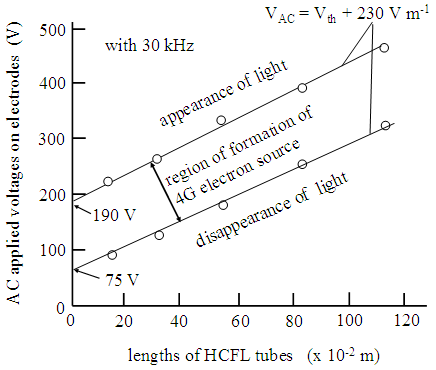 | Figure 11. Experimental results of appearance and disappearance voltages of lights from HCFL lamps under inverter driving circuit (30 kHz), as function of lengths of HCFL lamps |
 | Figure 12. Illustration of experimental arrangement for lighting of HCFL lamps in 1.0 m long under AC 300V with 30 kHz by Teslar Coil |
2.3.3. Incorrect Determination of AC Electric Power Consumption, Wact, of Lighted HCFL Lamps
- We back to the established data of the electric power consumption of the HCFL lamps in the published papers and handbooks. The developers of the HCFL lamps for the last 90 years did not well understand the lighting mechanisms of the HCFL lamps. Fortunately, they had empirically found the HCFL lamps in any lengths brilliantly light up with the AC driving circuit of 50 Hz (or 60 Hz). Now the HCFL lamps are operated with AC inverter circuits with the frequencies higher than 30 kHz. The developers of the HCFL lamps had concentrated the lighting lamps that allowed the mass production. According to their results of the HCFL lamps, they have obstinately believed thermoelectrons from the heated BaO on the W-filament coils. Then, they made the energy share diagrams of the working HCFL lamps as shown in Figure 15. The items in Figure 15 look like well analyze the lighting mechanisms of the HCFL lamps. However, there are many questions for the determinations. For instance, input power for the generation of the light of the HCFL lamp is 40 watt. For the confirmation of the electric power consumption of the 40W-HCFL lamp, we have analyzed the power consumption of the commercial 40W-HCFL lamp. Figure 14 illustrates the ballast AC driving circuit of the commercial 40W-HCFL lamp and waveforms of the electric current at the AC driving circuits. The ballast circuit is composed with two parts that are the choke coil and the HCFL lamp. We have detected the sine waveform at each component, except for the electrodes of the HCFL lamp. Here arises a misunderstanding of the evaluation of the waveform at the electrodes of the HCFL lamps. They have believed that the electrode (cathode) of the HCFL lamps detects the thermoelectron emissions into the Ar gas, and that the electrode (anode) at other side corrects arrived electrons from the Ar gas. This is a wrong assignment. Furthermore, the light from the HCFL lamp is generated by the 40 watt. The determined 40 watt at the electrodes does not relate to the energy for the generation of the light from the HCFL lamp.
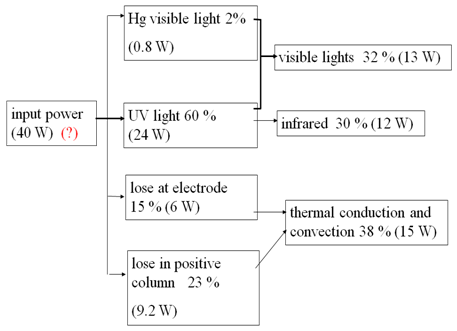 | Figure 13. Energy loss diagram of lighted 40W-HCFL lamp under AC operation with 50 Hz [8-10] |
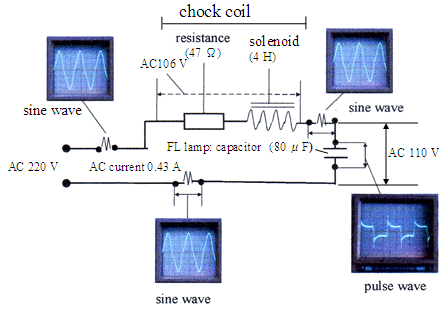 | Figure 14. AC driving circuit (ballast) of 40W-HCFL lamp with waveforms at components |
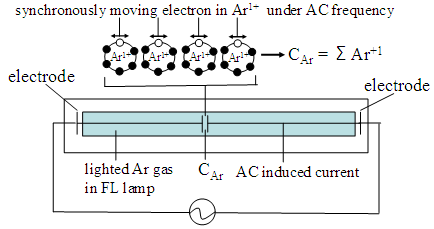 | Figure 15. Formation mechanism of capacitor CAr in lighted FL lamp |
2.3.4. Harmless Mercury (Hg) Atoms in FL Lamps to Human Health
- Before the description of the use of the Hg atoms in the FL lamps, we would like to clarify other fake story that is the hazardous mercury (Hg) atoms in FL lamps. In the past 50 years, the annual production volumes of the FL lamps on the world were multibillions each year. There is no report of the brain damage of the people by the Hg atoms. This is because the FL lamps use inorganic Hg atoms. The inorganic Hg atoms are harmless for the human body. Therefore, we can produce the FL lamps as the harmless products for the human health. The fake story has generated from the Japan. Recently, there is a proposal of the hazardous Hg atoms in the FL lamps from the Japanese Government to the Paris Agreement by the United Nation by using the Minamata disease in Japan. The Minamata disease is actually caused by the uncontrolled drain water from a specified chemical factory to the Minamata Bay. The drained water from the factory contained the organic methane mercury (CH3Hg) that is the dangerous compound in the living mater on the Earth. The Minamata disease is the responsibility of the Japanese Government by the uncontrolled drain water from the chemical factory. The Minamata disease never occurs with melted Hg atoms. According to the very recent TV programs, the Japanese Government confirms the Minamata disease is not caused by the metallic Hg atoms. The Minesota Disease limit in the very small area of the fishing villages at the Minamata bay. The Japanese Government cannot extend the Minesota Disease to the control of other products that use the useful atomic Hg. The atomic Hg droplets are safe for the human health. The Japanese proposal to the United Nation clearly indicates the scientific knowledge of the Japanese Government to the world. We have carefully studied the biological science of the CH3Hg. We have found the scientific reason why Minamata disease occurs with the persons in the limited small fishing villages at Minamata Bay and the small agricultural villages at around Minamata city. There is no report of the disease from the residents in the Minamata city and other areas in Japan. Why the Minamata disease was limited in the fishing villages and around mountain villages? The disease by the catalytic CH4Hg solution in the fishing village occurs with the organic cycles in the living body on the Earth. As a large amount of the organic CH4Hg solution discharges to the seawater in the Bay, the organic CH4Hg in the light density float in the sea water. The small droplets of Hg atoms have the high density so that the small Hg droplets immediately sediment on the bottom of the water. The bacteria in the sea water first takes the floating organic CH4Hg compounds in to the cells of the bacteria. As the small fishes, shellfishes, and shrimps in the sea of the Minamata Bay eat the contaminated bacteria, the organic Hg, not Hg atom, selectively concentrates in the brain and innards of them. The meats of the small fishes are not contaminated with the organic Hg. When the mother in the fishing villages eats the small fishes without removal of the head and innards of the contaminated small fishes, her body is contaminated with the organic Hg, but the mother does not have the serious trouble in the daily activity. When the mother is pregnant, the brain of the embryos in the mother selectively receives the contaminated organic Hg from the mother. The only brain of the embryos is seriously damaged by the received organic Hg but body is not damage, like as the case of the Ziga Virus. The serious Minamata disease is limited in the new born babies. The residents in Minamata city, who eat the meets of the large fishes with the removal of the head and innards, never have the Minamata disease. If the Japanese Government controls the drain of the organic CH4Hg solution from the chemical factory at start, the Minamata disease never happened in the small fishing villages and around mountain villages at Minamata city. The regulation of the production of the FL lamps by the Japanese Government using the Minamata disease is unacceptable as the biological science. It is said again that the prohibition of the production of the FL lamps by using the poison of Hg atoms by the Japanese Government shows their knowledge of the officers and scientists in Japan to the world. We have a conclusion after the carful study that Hg droplets in FL lamps are safety for the human health. The characteristic properties of Hg atoms are below: The melting point of Hg atoms is -39°C and boiling point is at 356°C. At around room temperatures, Hg atoms are melted phase (liquid). The melted Hg has a high density of 13.6 x 10-3 kg at 15°C. The melted Hg has the large surface tension of 464 (dyne cm-1). The melted Hg forms the droplets in the sizes at around 1 x 10-3 m, rather than thin layer or large droplets on the phosphor screen in the FL lamps. The vapor pressure of the Hg droplet at 20°C is 0.1 Pa (= 10-3 Torr) that is 10-6 times of the air (N2 + O2) that is 105 Pa (760 Torr). The density of the Hg droplets is 13.6 g per cm3. The vaporized Hg atoms stay in the bottom in the air atmosphere. With (a) the small droplets, (b) extremely low vapor pressure at room temperature (0.1 Pa), and (c) the high density, there is no report of the disease of the human health by the Hg droplets in the human history for 5 million years. Following is the real story with radon (Rn) in the polluted air. The dangerous poison gas on the Earth at present time is the radioactive (α-rays) radon (Rn) with the atomic number 86. The melting point of Rn is -71°C, boiling point is -62°C. At the room temperature, Rn atoms are gas phase. The density of Rn is 9.7 x 10-3 kg m-3. The polluted air in the big cities on the world contains serious amount of the Rn atoms in air. The Rn in the polluted air selectively and continuously deposits in the bottom of the air. Consequently, Rn continuously and selectively deposits in the bottom air in the holes on the grand. Especially the basement rooms in houses, basement of the large buildings, and underground shopping malls. The vapor of the radioactive Rn is the dangerous gas for the human body in the cities. If the air in the basement rooms is not continuously ventilated with the fresh air, the person who lives in the basement will be slowly and surely damaged the health of the human body by the radioactive α-ray from Rn. The reduction of the Rn gas in the polluted air is the serious problem in the cities on the industrialized countries. The reduction of the electric power generators on the world may reduce the polluted level of Rn in air. As described above, the use of the Hg droplets in the FL lamps is the safety on the human health. We have found that the FL lamps remain the large room for (a) the significant reduction of the electric power consumption, (b) improvement of the illuminance (lm, m-2) from the phosphor screens, and (c) extremely long operation life. We will challenge the remained subjects that are the revised lighting mechanisms of the FL lamps for the reduction of Rn from the electric power generators on the world.
3. Revised Lighting Mechanisms for Decisive FL Lamp
- As described above, the lighted FL lamps hold the decisive advantages that have not figured out in the past for 90 years. After the critical studies of the commercial 40W-HCFL lamps, we have found the latent potential of the decisive advantages of the lighted FL lamps. The FL lamps light up under the coexistence of the disparity of (i) the external driving circuit and (ii) the internal DC electric circuit in the operation [15]. There is no electron flow between external and internal electric circuits. The lights in the FL lamps are only generated by the moving electrons from the cathode to anode in the internal DC electric circuit in the Ar gas at the inside of the FL lamp. The basics of the FL lamps are the formation of the cathode and anode of the internal DC electric circuit inside of the FL lamps.
3.1. Formation of Cathode and Anode of Internal DC Electric Circuit in Ar Gas Space
- The experimental results in Figure 12 suggest us that the formation of the glow light of the Ar atoms is the trigger of the generation of the cathode and anode of the internal electric circuit in the FL lamps. After formation of the volumes of the glow light in the Ar gas space in the FL lamps, the insulating Ar gas space in the volume of the glow light may instantly break out. With this reason, we have made the volume of the glow light in the Ar gas space without the Teslar coil. The experiments are made by the volumes of the glow light on the needle metal electrodes in the vacuum-sealed glass tubes.
 | Figure 17. Illustrates flow of electrons from the cathode of glow light to plate metal anode |
 | Figure 18. Lighted glass tube which cathode and anode are formed by volume of glow lights on metal electrodes |
3.2. Direct evidence of Superconductive Vacuum between Electrodes of Internal DC Circuit
- The amount of the detected DC current at the needle electrodes is characteristically changed with the applied DC voltages to the needle electrodes. Figure 19 shows the detected DC current as a function of the DC applied voltages to the needle electrodes. As already described by the explanation of Figure 16, Ar gas space is electric insulator with the application voltage below 980 V. The Ar gas space between the electrodes is the electric insulator as shown in Figure 9. By the application of the DC 1.0 kV, the vacuum-seal glass tube lights up with the sky blue lights. As the applied voltages to the needle electrodes slowly increase to 10 kV from 1 kV, the needle electrodes hold the constant DC voltage at 1.0 kV. Whereas the DC current meters at the needle electrodes vertically increase with the applied voltages to the needle electrodes as shown in Figure 19. The size of the volume of the glow light on the needle electrodes does not change with the applied voltages.Thus, we have solved the confusion in the analysis of the moving electrons in the Ar gas space in the FL lamps. The confusion comes from the vacuum conditions in the unlighted FL lamps and in the lighted FL lamps. As already mentioned, the negative electric field fills up the vacuum space between Ar atoms in the unlighted FL lamps. On the other hand, the DC current vertically increases with above 1.0 kV shown in Figure 19. The vertical increase is a direct evidence of the existence of the superconductive vacuum in the vacuum-sealed glass tube. In the superconductive vacuum, the moving electrons do not have the electric resistance (R), so that there is no voltage drop by the V = RI = 0. The FL lamps are a kind of the vacuum-sealed glass tube that contains the Ar gas at 930 Pa (7 Torr) and Hg atoms at 0.1 Pa (= 1 x 10-3 Torr). We may change the naming of the tested glass tubes to the FL lamps that have the phosphor screen on the inside wall of the FL lamps.
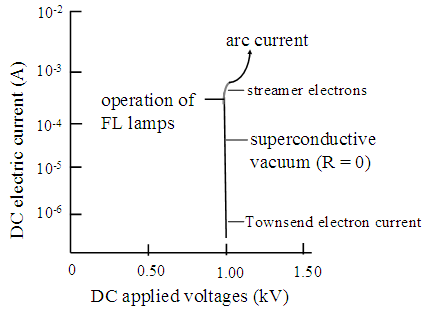 | Figure 19. DC electric current between volume of glow lights on needle electrodes in vacuum-sealed glass tube that contains Ar atoms at pressure of 930 Pa (7 Torr) |
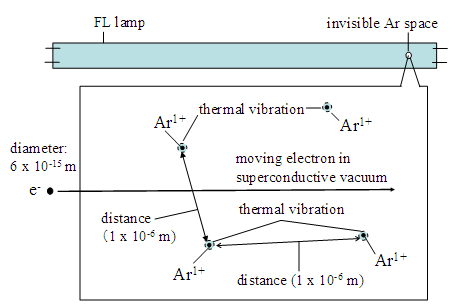 | Figure 20. Schematic illustration of superconductive vacuum for moving electrons in Ar gas space of lighted FL lamp with Ar gas pressure at 930 Pa (7 Torr) |
3.3. Reduction of External DC Electric Power Consumption of FL Lamps to WDC = 0
- The volumes of the glow lights in Figure 16 are formed by the electric field from the needle electrodes, and are not by the electron flow from the needle electrodes. They are formed by the electric field from the needle electrodes. With a curiosity of the formation of the volume of the glow lights on the needle electrode, we made the flowing experiments. The surface of the needle electrodes are covered with the thin glass layer less than 10-4 m. The thin glass layer on the needle electrodes is the electric insulator. The thin glass layer on the needle electrode cut off the electron flow from the needle electrodes to the volume of the glow lights. Figure 21 illustrates the experimental configuration of the needle electrodes that are covered with the thin glass layers of around 1 x 10-4 m thickness. Fortunately, we obtain the volumes of the glow light on the thin glass layer on the both cathode and anode electrodes by the application of DC voltages above 1.0 kV. The results lead us to the following experiments.
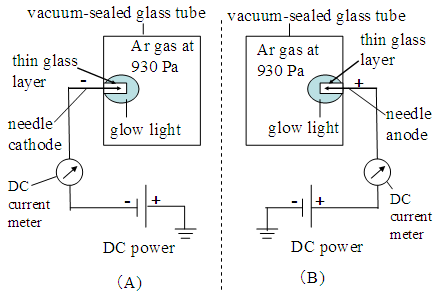 | Figure 21. Illustration of volume of glow light on thin glass layer on needle electrodes. Experiments are made with the DC voltage at 2 kV |
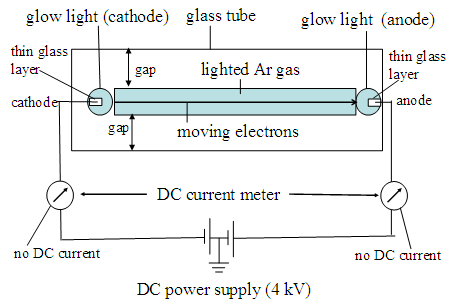 | Figure 22. Lighted FL lamp which cathode and anode are formed by volume of glow lights on thin glass layers on metal needle electrodes |
3.4. Calculations of Numbers of Ar1+ and Ar* (m3, s)-1 in Lighted FL Lamps
- The scattered electron in the FDC > Forb meets other Ar atom and generates Ar1+. Figure 23 illustrates the moving electron in the superconductive vacuum with the ionization of two Ar atoms in the superconductive vacuum. The moving electron in the superconductive vacuum continuously meets the floating Ar atoms in the superconductive vacuum until the reduction of the kinetic energy to 15.7 eV for the excitation of Ar atom (Ar*). After the excitation of the Ar*, the moving electron recombines with the Ar1+, and Ar1+ returns to Ar atom.
3.5. Astronomical Quantum Efficiency of 1013 Visible Photons (m3, s)-1 in Lighted FL Lamp
- The Ar gas pressure of the commercial HCFL lamp (T-10) is 930 Pa (7 Torr). The numbers of the Ar atoms at 930 Pa (7 Torr) are 2 x 1018 per m3. The pressure of the vaporized Hg atoms at 40oC is 0.67 Pa (5 x 10-3 Torr) that is 7 x 10-4 times of the Ar gas pressure {= 0.67 Pa x (930 Pa)-1}. The numbers of the vaporized Hg atoms in the HCFL lamp is calculated as 1.4 x 1015 Hg atoms (m3)-1 (= 2 x 1018 Ar atoms x 7 x 10-4). For the excitation of one Hg atom, the moving electron must have the 63 scatterings by the Coulomb’s repulsions before the excitation of the Hg atom. The calculated numbers of the Hg* in the Ar gas space at 40oC is 2 x 1013 Hg* (m3, s)-1 (= 1.4 x 1015 x 63-1). The calculated 2 x1013 Hg* (m3, s)-1 are the quantum efficiency ηq of the Hg* by one moving electron in the lighted 40W-HCFL lamps. The total numbers of the Hg* in the FL lamps are given by the multiplication of the numbers of the moving electrons. The moving electrons in the internal DC electric circuit are 3 x 10-4 A that contain 2 x 1015 electrons per second {= 3 x 10-4 A x (1.6 x 10-19 Coulomb)-1}. Therefore, the numbers of the generated Hg* in the FL lamp are 4 x 1028 UV photons (m3, s)-1 (= 2 x 1013 Hg* x 2 x 1015 electrons per second). The calculated result can apply to the commercial HCFL lamps.Now we calculate the numbers of the Hg* in the commercial 40W-HCFL lamp. Since the inner volume of the commercial 40W-HCFL lamp is 7 x 10-4 m3, the commercial 40W-HCFL lamp must emits 2.8 x 1025 UV photons per second {= 4 x 1028 (m3, s)-1 x 7 x 10-4 m3}. As described latter, the volume of the positive column is a half of the inner volume of the glass tube of the commercial 40W-HCFL lamps. The commercial 40W-HCFL lamps emit 1.4 x 1025 photons per second (= 2.8 x 1025 x 2-1). The phosphor screen on the inside wall of the FL lamps transduces the UV photons to the photons in the visible spectral wavelengths with the ηq ≈ 1.0. Therefore, each commercial 40W-HCFL lamp emits 1.4 x 1025 visible photons per second. Human eyes have adjusted for 5 million years to the daytime scenery under the slightly overcastting sky that is given by the around 1025 visible photons (m2, s)-1. The calculated results coincide with the illumination level by one commercial 40W-HCFL lamp. The commercial 40W-HCFL lamp already illuminates comfortably the 1 m2 room with the daytime scenery under the slightly overcastting sky. We have theoretically and experimentally proved the performance of the commercial 40W-HCFL lamps with the astronomical quantum efficiency ηq = 2 x 1013 visible photons per second. The remained subject is the reduction of the AC electric power consumption (WAC ≈ 80 watt) of the external AC driving circuit of the commercial 40W-HCFL lamps.
4. Development of Coil-EEFL Lamps as Most Advanced Incandescent Lamps
- As described in previous section, the lighted FL lamps actually operate with the internal DC electric circuit that the cathode and anode are formed with the volumes of the glow light in the Ar gas. The volumes of the glow light are formed by the electric field from the needle electrodes of the external driving circuit, without the electron flow. The use of the needle electrodes in the practical FL lamps is not convenient. We must find out a simple way that forms the volumes of the glow light in the Ar gas space, rather than needle electrodes.
4.1. Coil-EEFL Lamps by Polarized Phosphor Particles
- A candidate for the formation of the volume of the glow light in the Ar gas space is the polarized phosphor particles in the phosphor screen. The phosphor particles are polycrystalline particles in the sizes at around 5 x 10-6 m. Furthermore, the practical phosphor particles are the good piezoelectric crystals that easily deform the polarized particles under the electric field. We have carefully studied the details of the growths of the each phosphor particle in the heated crucibles [5]. By the control of (a) the temperature profile in the production furnace and (b) heating program of the crucibles in the furnace, we have the individual particles that are well crystallized polycrystalline particles [5]. Each polycrystalline particle contains many growing axes that make the sharp edge lines and points on the surfaces of the particles. The sharpness of the edge lines and points is less than 1 x 10-7 m. Figure 24 shows, as an example, the photograph of the developed phosphor particles under the scanning electron microscope (x 3000). The sharp edges and points on the surfaces of each polarized phosphor particles may work as the sharp points like as the needle electrodes.
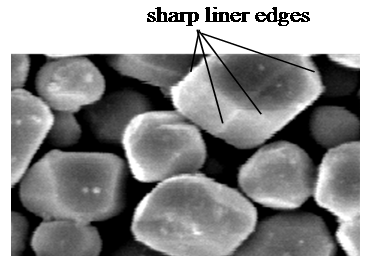 | Figure 24. Photograph of phosphor particles under scanning electron microscope (x 3000) |
 | Figure 25. Photopicture of lighted coil-EEFL lamp under DC voltage at 2 kV |
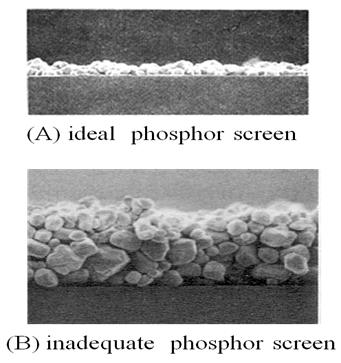 | Figure 26. Cross-section of phosphor screen in coil-EEFL lamp (A) and in commercial HCFL lamp (B). Photograph are obtained with scanning electron microscope (x 1000) |
 | Figure 27. Illustration of polarized phosphor particles in screen by electric field from external electrode and formation of volume of glow lights as internal cathode (or anode) in Ar gas space |
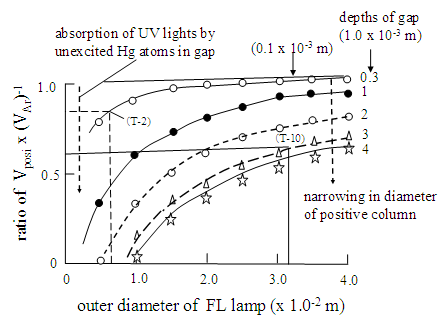 | Figure 29. Curves of (Vposi x VAr-1) of FL lamps as a function of outer diameters of FL lamps. Parameter is depth of gap in FL lamps |
 | Figure 30. Voltage dependence curves of low voltage CL phosphor screen and PL phosphor screen. Low voltage dependence curves change with thickness of phosphor particles in screen |
 | Figure 31. Build-up curves of light of FL lamp having (Vposi x VAr-1) = 0.8 and Commercial HCFL lamp that has (Vposi x VAr-1) = 0.6 |
4.2. Lighted coil-EEFL Lamps Set in Vacuum-Sealed Sheath Tube
- The coil-EEFL lamps must have the very shallow gap between positive column and phosphor screen; hopefully less than 1 x 10-4 m. We have obtained 10 CCFL lamps in the outer diameter 3 x 10-3 m from a FL store. The CCFL lamps of the Ar gas pressures at 6.7 x 103 Pa (= 50 Torr) have the 3 x 10-4 m depth of the gap. The 10 CCFL lamps convert to the coil-EEFL lamps. Following experiments are made with the converted coil-EEFL lamps. The power consumption of 10 coil-EEFL lamps in parallel connection is zero, WDC =0. The coil-EEFL lamps are operated with the external DC driving circuit with 3 kV. Individual coil-EEFL lamps lights up with the illuminance (1200 lm, m-2) with the WDC = 0. The illuminance is determined the Ulbricht Sphere in which is incorrectly modified by the reflection plate [18]. Therefore, the determined illuminance is the relative illuminance. The bottom line in Figure 32 shows the results. Then, the EEs of the 10 coil-EEFL lamps are arranged with the parallel connection in the room. The illuminance of the coil-EEFL lamps in air does not linearly increase with the numbers of the parallel connections as shown in Figure 32. The outer glass wall of the coil-EEFL lamps are cooled with the thermal convention of the cool air in the room. When the coil-EEFL lamps set in the vacuum-shield sheath tube, the illuminance of the coil-EEFL lamps linearly increases with the numbers of the parallel connection of the coil-EEFL lamps as shown in Figure 32. The vacuum pressure of the vacuum-shield sheath tube is 600 Pa (= ~ 5 Torr). The vacuum sealed containers should be opaque for the practical use for the generation of the shadow less images.
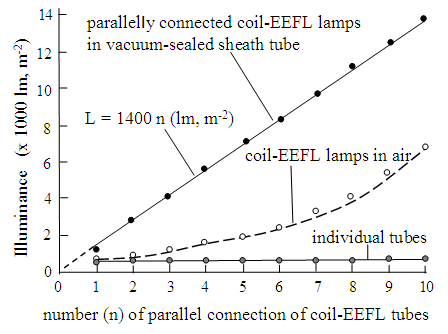 | Figure 32. Illuminance (lm, m-2) curves of individual coil-EEFL lamps, coil-EEFL lamps with parallel in air, and coil-EEFL lamps in parallel connection in vacuum-sealed sheath tube |
5. Conclusions
- We have studied the established incandescent lamps from the basics that are the arrangements of the atoms in the vacuum. The electrons move on in the bounding shell of the metal. Naturally, moving electrons have the electric resistance caused by the thermal perturbation from the neighbor atoms. The W-filament lamps use the heated metal at the high temperatures by the Joule Heat. The LED lamps use the moving electrons in the vacuum between atoms at lattice sites. The lights from the LED lamps are generated by the recombinations of the injected electrons and holes in the luminescence centers, giving rise to the ηq less than 1.0. Furthermore, the injected electrons that move on in the narrow vacuum between atoms at the lattice sites inevitably have the electric resistance caused by the thermal perturbation from atoms at lattice sites. As the illumination source, the LED lamps must inject, at least, 1025 electrons (m2, s)-1 for the illumination purpose. The injection of the large numbers of the electrons to the LED lamps generates the very high temperatures by Joule Heat. The stability of the luminescence centers in the junction of the LED lamps requires the operation temperature below 70°C. On the other hand, the FL lamps use moving electrons in the superconductive vacuum between Ar atoms that float in the vacuum, (not at the lattice sites) resulting in the astronomical quantum efficiency of ηq = 1013 visible photons (m3, s)-1. The superiority of the FL lamps has obscured in the study for nearly 90 years with (i) the wrong assignments of the vacuum between Ar atoms, (ii) incorrect determination of the electric power consumption, Wact, of the external AC driving circuit, (iii) the coexistence of the disparate external driving circuit and internal DC electric circuit in the operation of the FL lamps, (iv) hypotheses of the electron sources, (v) ignorance of superconductive vacuum in the Ar gas, (vi) miscalculation of the generation energy of the lights, (vii) lighting mechanisms of the Hg atoms in the Ar gas, (viii) unknown of the existence of the capacitor, CAr, in the lighted FL lamps, and (ix) unknown of the vertical electric filed Fphos from the contaminated phosphor screens. After the clarification of all of them, we have developed a prototype of the coil-EEFL lamps that are operated with external DC driving circuit with WDC = 0. The cathode and anode of the internal DC electric circuit in the FL lamps are formed in the Ar gas space with the volume of the glow lights on the needle electrodes. The volume of the glow lights as the cathode and anode are also formed under the electric field from the external electrodes (EE) on the outer glass wall of the FL lamps. The phosphor particles on the inner glass wall of the FL lamps form the volume of the glow lights by the electric field from the EE. The results lead us to the development of the coil-EEFL lamp. The electrons from the cathode move on in the superconductive vacuum to the anode of the internal DC electric circuit. The moving electron in the superconductive vacuum gives the astronomical quantum efficiency ηq = 2 x 1013 photons (m3, s)-1. The maximum electron current between the cathode and anode of the internal DC electric circuit is 3 x 10-4 A, corresponding to the numbers of 1015 electrons. The generated photons from the coil-EEFL lamps are 1028 visible photons (m3, s)-1. The fundamental mechanisms of the coil-EEFL lamps have studied in this report for the production of the coil-EEFL lamps by someone else. The author is 85 years old with the cancer. He hopes someone continue this project for the contribution to Green Energy Project by UN in a near future. If someone needs his help, he may help you in the left of his life.
ACKNOWLEDGEMENTS
- The author wishes to express his great appreciation to Mr. Nobuyoshi Ohtani and Dr. Takao Toryu for their instruction and chance to early study on the characteristic properties of the phosphor powders from the basics with the hand-made instruments in the small laboratory modified from the green house in Chigasaki, Japan before 1953. They also instructed the author that the results of the study are for human society rather than personal benefit. Since then, the author has continued his study on the materials by the hand-made instruments for the development of the new products on his life for the society.
Appendixes
- In early study on the FL lamps, the neon tubes had studied as the lighting lamp. Because the Ne atoms release a small amount of the heat by the ionization of small number of the Ne atoms, the FL tube with Ne gas did not absorb the attention as the illumination source. We have found that the volumes of the glow light by the Ne atoms are also formed by the electric field from the EEs on the outer glass tube. We may have the cathode and anode of the internal DC electric power generator in the Ne gas space. We also know that the Xe atoms are in gas phase. So the heating Xe toms in the FL lamps are unnecessary in the operation of the coil-EEFL lamps. Xe atoms also emit the UV light at 172 nm and 142 nm in the vacuum ultraviolet lights. The adequate phosphor screen may transduce the vacuum UV lights to the lights in the visible spectral wavelengths. The coil-EEFL lamps may produce with the combination of Ne and Xe gases, without Hg droplets. The gas pressure of Ne atoms is around 103 Pa (~ 7 Torr) and the gas pressure of Xe atoms is around 2 Pa (~ 10-2 Torr). The melting temperature of Xe is -112°C, and boiling temperature is -107°C. Xe at room temperature is always gas phase. The lighted FL lamps do not require the heat for the Xe atoms. The emitted UV lights from the excited Xe* are at 172 nm and 142 nm in the vacuum UV range. The preferable phosphor screens for the FL lamps by the mixture of Ne and Xe gases are (a) BaMgAl10O17:Eu as the blue light, (b) Zn2SiO4:Mn as the green light, and (c) Y2O2S:Eu as the red light. The plasma display panel (PDP) uses (Y, Ga)BO3:Eu phosphor as the red lights. However, the control of the sizes and surface conditions of the (Y, Ga)BO3:Eu phosphor is a very hard. We recommend the use of the Y2O2S:Eu red phosphor powder that each phosphor particle has the sharp points and sharp edges [5]. Furthermore, sulfur in the Y2O2S:Eu red phosphor does not have the chemical reaction with Xe atoms. The study on the coil-EEFL lamps by the combination of Ne and Xe gases is underway.
 Abstract
Abstract Reference
Reference Full-Text PDF
Full-Text PDF Full-text HTML
Full-text HTML